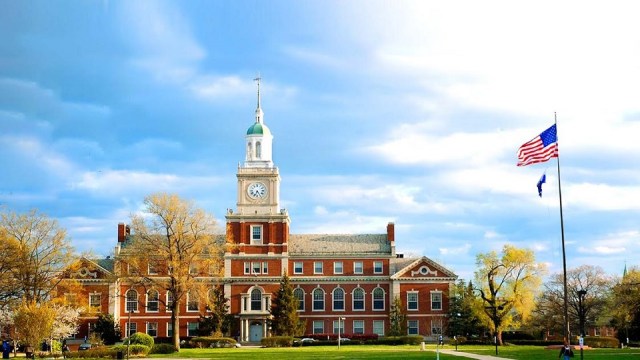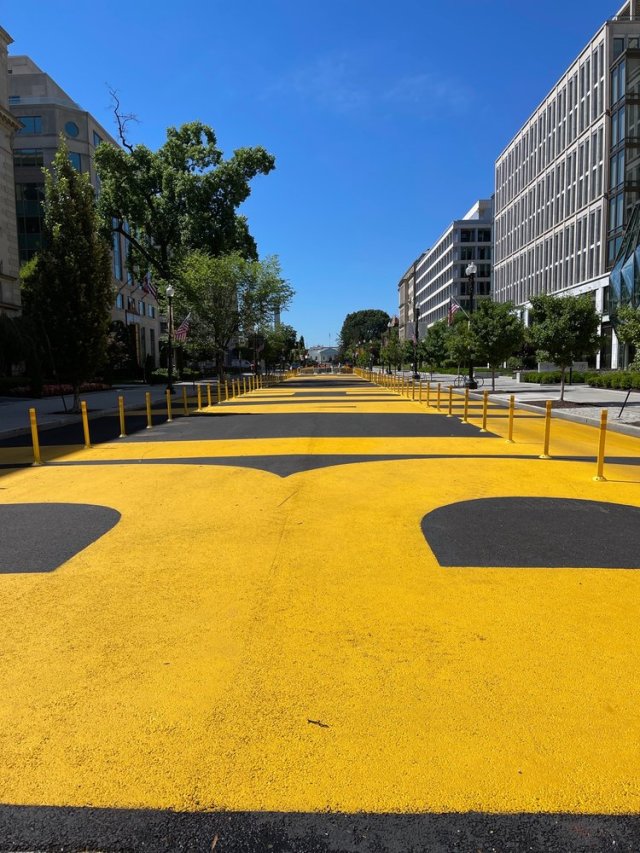Explore one of DC’s many historically Black neighborhoods and Black historic sites and landmarks in celebration of Black History Month this February. From reflecting on the Civil Rights movement on the National Mall to getting a hands-on education about Black Civil War regiments at the African American Civil War Museum, we’ve rounded up some of the most notable sites and some off-the-beaten path locations to help guide you when exploring Black history here in DC.

Howard University & Founders Library
Home of the Bison, this historically Black university sits on the edge of the U St. corridor (see below) in DC's Shaw neighborhood. Famous graduates includes our first Black, first Asian and first woman Vice President Kamala Harris, the Supreme Court's first Black justice Thurgood Marshall, author Toni Morrison, the first Black mayor of NYC David Dinkins and more. The university's library, Founders Library, is listed on the national registry of historic places; it's bell tower can be seen prominently beyond campus.
Editor's Note: Founder's Library is temporarily closed to the public.
2400 6th St. NW
Shaw
Online: howard.edu

The Shaw 54th Regiment Memorial
This memorial depicting one of the first Black Union regiments formed during the Civil War is on permanent display in the National Gallery of Art. The bronze work of art depicts Colonel Robert Gould Shaw parading to the Boston docks before departing for South Carolina with his troop. When you visit, be sure to check out this National Park Service guide that shares the 1,500 names of the men who served this regiment.
Constitution Ave. NW, Between 3 & 9th St.
National Mall
Online: nga.gov

Black Lives Matter Plaza
Stretching two blocks on 16th St. (south of K St.), the Black Lives Matter Plaza feature a boldly painted yellow mural in all caps declaring: Black Lives Matter. The Plaza along with a street sign bearing the same name, were dedicated on June 5, 2020 (the birthday of Breonna Taylor). Originally used as grounds for demonstrations due to the close proximity to the White House, in Oct. of 2021 it became a permanent installation and remains a pedestrian-friendly walkway where people often come to photograph the 50 ft. letters.
Starting at K & 16 St.
Downtown DC

Frederick Douglass National Historic Site
It took two generations to establish and restore this spot as a National Historic Site. Cedar Hill, the Southeast DC home where escaped slave turned preeminent orator and scholar, Frederick Douglass, lived his final years. Now serving as an educational center, Cedar Hill runs tours, and sponsors family-friendly events throughout the year, including Douglass’s birthday celebration.
Insider Tip: You can tour this property from the comfort of your home here.
1411 W St., SE
Anacostia
202-426-5961
Online: nps.gov

The U Street Corrridor
The U St. corridor was once known as the Black Broadway district. Flanked by Howard Theatre on the east end and 14th St. on the west, this neighborhood was DC's cultural epicenter from the early 1900s to the mid '60s. Explore this cultural stomping ground by starting at Howard Theatre, the iconic stage where legends like Duke Ellington, Ella Fitzgerald, Billie Holliday and Nat King Cole got their start and heading northwest and pass the Bohemian Caverns (a former speakeasy hidden by a first floor pharmacy where Duke Ellington was a frequent performer), and continue west to historic Lincoln Theatre; don't forget to stop in near-by DC landmark Ben's Chili Bowl, a black-owned
620 T. St.
U St./Shaw
Online: thehowardtheatre.com

Edmonson Sisters Statue
Pay tribute to the iconic abolitionists Mary and Emily Edmonson. The bronze memorial at 1701 Duke St. in Alexandria (directly across the street from Whole Foods) sits steps away from the former the Bruin's Jail where the sisters, then 15 and 13, were held after they tried to escape the clutches of slavery on a New Jersey-bound schooner, The Pearl. The sisters were later freed by their father (with the help of a abolitionist and minister Henry Ward Beecher) when he paid $2,250 for their emancipation. Bruin's Jail is now an office building, but you can read the historical plague in front of it at 1707 Duke Street.
1701 Duke St.
Alexandria, VA
Online: slaverymonuments.org

Visit the Martin Luther King, Jr. Memorial
To honor the most powerful voice of the Civil Rights movement, this memorial has 15 quotes etched in granite to inspire the next generation. From "Out of the mountain of despair, a stone of hope" on the Martin Luther King Jr. statue to "True peace is not merely the absence of tension; it is the presence of justice" on the north wall, these inscriptions etched in granite offer a chance for families to collectively reflect on some of Martin Luther King Jr's most moving words.

Step Into History at the Lincoln Memorial
Take a ten minute walk from the Martin Luther King Jr. Memorial and you will reach the steps of the Lincoln Memorial where Martin Luther King Jr. delivered his most famous speech, "I Have a Dream." Step into history; eighteen steps from the top of the memorial is an inspiration dedicated to the very spot Martin Luther King Jr. stood when he addressed the crowd of 250,000 on the National Mall.
Editor's Tip: Take part in history! Download the "I Have a Dream" speech from PBS and listen to it as you stand in the very spot it was delivered. You'll also find educational lessons to do at home on the PBS site.
2 Lincoln Memorial Cir. NW
National Mall
Online: nps.gov/linc/

Mt. Zion United Methodist Church
This church is the oldest Black church in Washington, DC. Once a slave and tobacco trading site in the early 1800s, it became a church in 1816 and later a station on the Underground Railroad during the Civil War. It is believed a vault on the Burial Grounds was used to hide enslaved people as they made their way north. You can learn more about the church's history as well as the original Black citizens of Georgetown at the church's Heritage Center (2906 O Street). To note: tours are by appointment only. Other near-by points of interest on Georgetown's African American Heritage Trail include Rose Park Recreation Center, the John H. Fleet residence, the Emma V. Brown residence, and more.
1334 29th St. NW
Georgetown
202-234-0148
Online: mtzionumcdc.org

National Museum of African-American History and Culture
The stunning building, inspired by Yoruba art and filigree ironwork, is filled with presentations and artifacts that give visitors a glimpse at all aspects—the good and the gut-wrenching—of the African American experience. It’s a must-visit for the entire family. See our in-depth guide here.
Editor's Note: This museum is closed on Mon.-Tues. Get your timed entry pass here.
1400 Constitution Ave. NW
National Mall
Online: nmaahc.si.edu

Mary McLeod Bethune Memorial

African-American Civil War Memorial (Spirit of Freedom)
"Spirit of Freedom,' which sits at the corner of Vermont Avenue and 10th Street, honors the 209,145 Black soldiers and officers who served under the Bureau of United States Colored Troops in the fight to free enslaved Black Americans. Across the street, you'll find the African-American Civil War Museum. Tours of the actual museum are by appointment only; this living museum has a number of must-book programs that bring history to life through re-enactments, including the one-hour, award-winning School of the Soldier program for elementary and middle schoolers.
1925 Vermont Ave. NW
Shaw
Online: nps.gov
WORTH-THE-DRIVE

Explore Richmond's Legacy
Richmond is steeped in important Black history and here are just a few of the ways you can experience it with your kids.
Visit the home of Maggie Lena Walker, a newspaper editor, bank president and champion of civil rights for African Americans and women. Join a tour of her home and an exhibit hall, watch a short film about her life and walk in the footsteps of a great activist of the early 20th century. There's also a Maggie L. Walker Memorial Plaza.
The Black History Museum & Cultural Center of Virginia celebrates the rich culture and history African Americans people in Virginia and has permanent exhibits that explore Jim Crow, Reconstruction, Emancipation and more.
You can also explore Richmond’s monuments: Virginia Civil Rights Memorial on the Capitol grounds, Slavery Reconciliation Statue, Henry Box Brown, Bill “Bojangles” Robinson monument and the Arthur Ashe monument on Monument Ave. There's also a self-guided Richmond Slave Trail: Walk along and discover seventeen different markers that display the somber truth about slavery in Richmond.
At the Virginia Museum of Fine Arts entrance along historic Arthur Ashe boulevard, you'll find Rumors of War, a powerful sculpture by Black artist Kehinde Wiley’s. You'll also currently find the the Marcus-David Peter Circle (Robert E. Lee Monument) where artist Dustin Klein's light projections on the statue of Robert E. Lee include images and videos of Black citizens who are victims of police brutality, including Breonna Taylor and George Floyd, as well as projects of iconic Black leaders like Frederick Douglass, Harriet Tubman, Billie Holiday, and Malcom X.
Discover even more at visitrichmondva.com
––Meghan Yudes Meyers and Ayren Jackson-Cannady
RELATED STORIES:
28 Black History Month Resources for Kids of All Ages
7 Important Places to Visit with Kids for Black History Month
6 Actionable Ways to Celebrate Black History Month, Every Day
Dear Parents, Black History Is American History
10 Movies to Educate & Entertain Kids During Black History Month
